Way 3: As a meta-literary investigation of storytelling.
This is an episode where it’s really helpful to think about Roland Barthes’ narrative codes. (For an explanation of these, see wikipedia here – for my particular take on them, see our series on the philosophy of Batman.) In particular, we’re going to be looking at the hermeneutic code, HER (i.e. the big overarching questions that drive the narrative forward), and the proairetic code, PRO (i.e. the mundane A then B then C series of actions that make up the narrative being driven forward). “Good storytelling,” in the populist, screenwriting-seminar sense of the term, requires both of these. For instance, let’s say we’re writing a little scene from a detective novel. First I’ll give you a version with most of the HER boiled out of it:
Walking out of the nightclub, private investigator Dirk Hammerthrust shivered and pulled his trenchcoat tighter around his lanky frame. As he crossed the street, another man came up behind him. The two men continued down DeGraw street. At the corner, Dirk stopped, fished out a cigar, and began to search his pockets for matches. Finding one, he lit the stogie and took a long, satisfying drag. Spinning on his heel, he slugged the other man square in the jaw, sending him sprawling.
This isn’t completely without HER – I’m sure you all wanted to know how Dirk would react to the man that’s following him, and still want to know why he hit the guy. But I tried to make it as neutral as possible. Now here’s a version that’s HER and only HER:
A dark, shadowy form detached itself from the darker shadows of an abandoned alleyway, and began to follow Dirk Hammerthrust, P.I., timing its footsteps to match his. Suddenly, out of the corner of his eye, Dirk saw his follower, and adrenaline shot through his veins. He’d know that scar anywhere! Torkleson!
Again, this isn’t without PRO: we still know that Torkleson is following Hammerthrust, which is a description of an action. But it’s phrased to reinforce the hermeneutic content. The detail about the footsteps suggests that Torkleson is trying to avoid detection, so naturally we’re wondering whether he’ll be detected, and then there’s all the “dark,” “shadowy,” “abandoned alleyway” business, which reinforces the follower’s status as a mystery to be solved, and any actions that don’t contribute specifically to that question have been removed.
Both of these versions are pretty bad, which is why I said that you typically need PRO and HER together:
Walking out of the nightclub, private investigator Dirk Hammerthrust shivered and pulled his trenchcoat tighter around his lanky frame. As he crossed the street, a dark, shadowy form detached itself from the darker shadows of an abandoned alleyway, and began to follow him, timing its footsteps to match Dirk’s. The two men continued down DeGraw street. At the corner, Dirk stopped, fished out a cigar, and began to search his pockets for matches. Finding one, he lit the stogie and took a long, satisfying drag. Suddenly, out of the corner of his eye, Dirk saw his follower, and adrenaline shot through his veins. He’d know that scar anywhere! Torkleson! Spinning on his heel, Hammerthrust slugged the other man square in the jaw, sending him sprawling.
Now we’re cooking with gas! I mean, it’s still terrible, but it’s better. What’s really interesting about this kind of writing is that it’s more than the sum of its parts. PRO is transformed by its HER context: in the first passage, the punch to the jaw was just a punch, but in this version, you feel the hate behind it. We understand that Hammerthrust has poor impulse control, or at least that Torkleson brings out the thug in him. So it’s not just enough to have PRO and HER to make good writing. HER needs to inform PRO, which is another way of saying that when the characters learn something, it should effect their behavior.
But note that this isn’t the only way that these specific PRO and HER elements can be combined!
Walking out of the nightclub, private investigator Dirk Hammerthrust shivered and pulled his trenchcoat tighter around his lanky frame. As he crossed the street, a dark, shadowy form detached itself from the darker shadows of an abandoned alleyway, and began to follow him, timing its footsteps to match Dirk’s. The two men continued down DeGraw street. Suddenly, out of the corner of his eye, Dirk saw his follower, and adrenaline shot through his veins. He’d know that scar anywhere! Torkleson! At the corner, Dirk stopped, fished out a cigar, and began to search his pockets for matches. Finding one, he lit the stogie and took a long, satisfying drag. Then, spinning on his heel, he slugged the other man square in the jaw, sending him sprawling.
Again, HER has an effect on PRO. But in this version, we learn very different – contradictory, in fact! – things about Dirk. Rather than having poor impulse control, he has the sang-froid to light up a cigar before taking his shot, just to throw Torkleson off balance. We can even take it further:
Walking out of the nightclub, private investigator Dirk Hammerthrust shivered and pulled his trenchcoat tighter around his lanky frame. As he crossed the street, a dark, shadowy form detached itself from the darker shadows of an abandoned alleyway, and began to follow him, timing its footsteps to match Dirk’s. The two men continued down DeGraw street. At the corner, Dirk stopped, fished out a cigar, and began to search his pockets for matches. Finding one, he lit the stogie and took a long, satisfying drag. Then, spinning on his heel, he slugged the other man square in the jaw, sending him sprawling. Suddenly, Dirk recognized his follower, and adrenaline shot through his veins. He’d know that scar anywhere! Torkleson!
This would seem to be a case where HER and PRO are disconnected, since we don’t get the hermeneutic closure until after all the PRO has taken place. But in fact it does: we learn that Dirk is so hard-boiled that he just punches dudes on instinct and asks questions later. And we know this in a way that we could not know it the story simply left us in the dark about when he recognized the man. The upshot of all this is that we, as human beings, have a story-making tendency. Not a tendency to write our own stories, necessarily, but a tendency to organize facts as they are presented to us into a coherent narrative. Given the slightest opportunity, we will find a way for HER to inform PRO.
So what does any of this have to do with Cowboy Bebop? Well like I said last time, as the show closes in on its final episodes, we’re seeing some changes in the way that the show relates to the idea of mystery and narrative closure. “Pierrot le Fou” is mysteries all over the place. For instance, here’s the first image of Pierrot that we get:
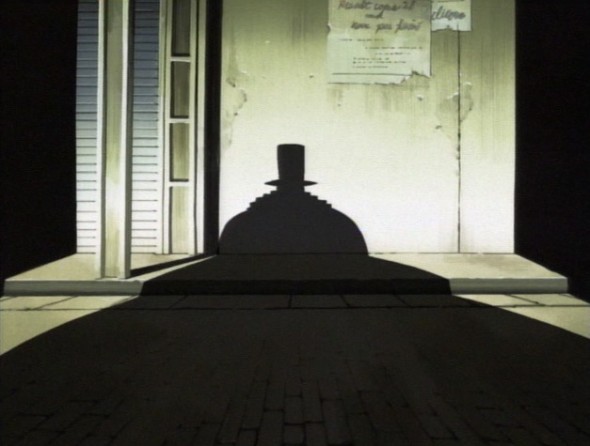
Are we not men? / We are Pierrot.
And here’s the second, which you may remember from the first page of this,
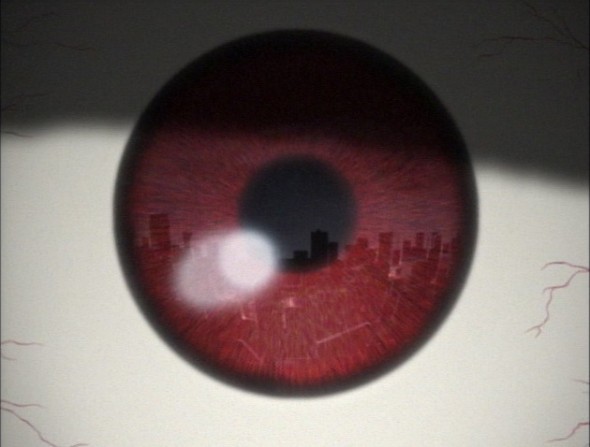
and the third
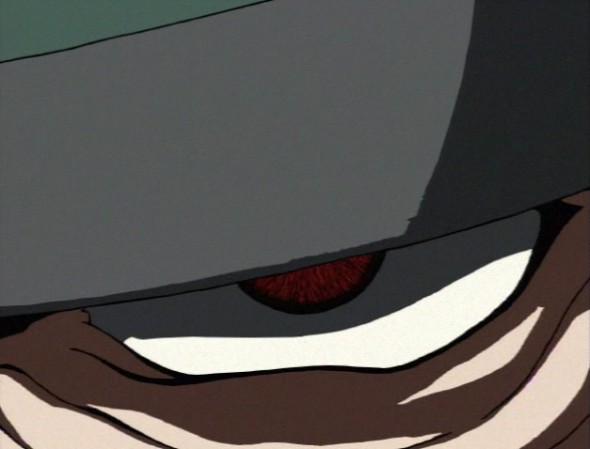
and the fourth
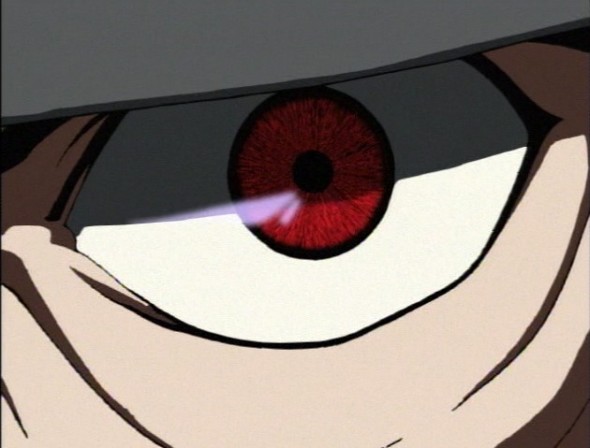
until finally we get this ugly mug
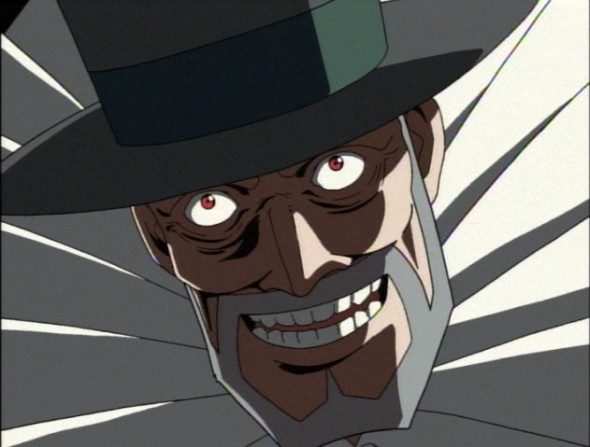
right before he commences to murdering everyone in sight. All of this is interspersed with shots from Pierrot’s POV as he floats over the city, and set to a soundtrack that’s as much ambient sound-design as it is music. The opening sets Pierrot up as a mystery, and then as the images transition from the mere absence of light in his shadow, to an anonymous quivering eyeball, to the same eye heavily shaded by a hat brim, to a clear shot of the eye, and then finally to the face itself, the mystery is slowly unveiled. This kind of thing is just good storyboard work. But the lengths that they take it to are pretty extreme.
The fight scene only raises more questions. Why can Pierrot move like that? Why is he bulletproof? Why does he hate cats? (For that matter, who is he? At this point we don’t know his name.) There’s also the question of whether, or at least how, Spike will be able to beat him. Being the well-trained little narrative engines that we are, we assume that we’ll learn most of these things with time, and that Spike’s victory will be in some way informed by what we learn. This, in fact, is almost the iron law of plotting in narratives with an action component: the central narrative mystery (that is, the big HER) should be about what specific actions the hero must take in order to defeat the villain (the PRO). Most typically, this means gaining some form of knowledge about the villain’s background or operating procedure. “Aim for the gap in the scales beneath his armpit!” and “Cover your heart, Indy!” are just two of the most obvious examples.
Oh, but I haven’t explained the rest of the plot yet! Spike does wind up meeting Pierrot at the amusement park, and they fight for a good long chunk of the show. It’s still very horrific.
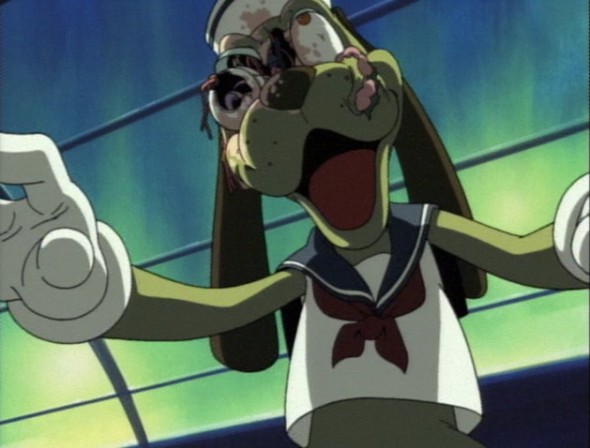
See, SEE?! Ugh. I *hate* that animatronic dog.
Plus, whatever steps Spike has been taking to prepare for this second confrontation are not paying off much: Pierrot is still pretty much in control of the fight, even when Faye shows up uninvited to lend Spike a hand. In the middle of this, we cross-cut to Ed hacking the ISSP mainframe, and we see the government assassin recruitment video I showed you up above. In DW Griffith, the rest would write itself. Ed just needs to get this crucial information (whatever it is) to her beleaguered crewmates before Pierrot kills them all, and everything will be fine.
Is this what actually happens?
Well, of course not. Instead, Pierrot and Spike end up squaring off again, in front of the approaching Electrical Parade.
Spike is once again in bad shape. He’s down to a single throwing knife, and he can’t keep dodging bullets forever. But then Pierrot notices that Spike’s eyes are two different colors, just like the eyes of the cat in the flashback. And he freaks out, big time, giving Spike the opportunity to hit him with the knife. (Pierrot’s invincibility appears to follow the Dune model, aka, the bloody stupid model, in which bullets bounce off but relatively slow moving objects like a knife sail right on through.) Pierrot breaks down crying, because. as we learned in voiceover, he still has the mind of a child. And then he gets trampled by the world’s most terrifying children’s parade.
And then, only then, Jet calls to give the report on Pierrot. Spike literally hangs up on him. After all, what does it matter at this point? Spike, who is fighting Pierrot, never learns about his background. Jet and Ed do (at least partially), and we – the audience – definitely do. We learn it at exactly the same point that we would in a normal show: when it cuts away from the fight to show us that montage, it feels totally appropriate, because the big reveal is supposed to come right at the climax of the show. And if WE were the ones fighting Pierrot, we would totally know what to do now: call in Adam West and his cat-launcher. (Waaaaaaiiit a minute. Adam West?! Batman!) But Spike never gets to hear about it, which means that it has no effect on his actions. And that makes “Pierrot le Fou” that rarest of animals, a story where HER and PRO do not connect. Or to think about it another way–in the last episode, “Wild Horses,” there was a big secret that the characters all knew, and the audience only got to see at the end; in this episode, there’s a big secret that the characters never know and the audience gets to see at the end.
I don’t think this is just a coincidence. Like my little example suggested, it is actually pretty hard to come up with a story that works like this. But it’s revealing that we got closure at all. In earlier episodes, the backstory and motivations of the bad guys were left mostly to our imaginations. Six episodes in from the end, we do get to have that closure, even if the writers are still jumping through hoops to make it the most distorted version of closure since Citizen Kane.
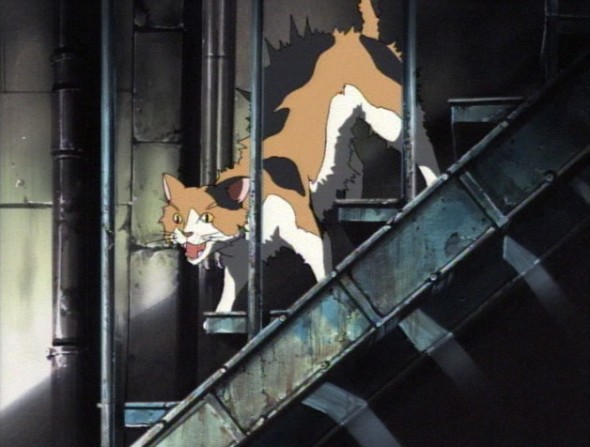
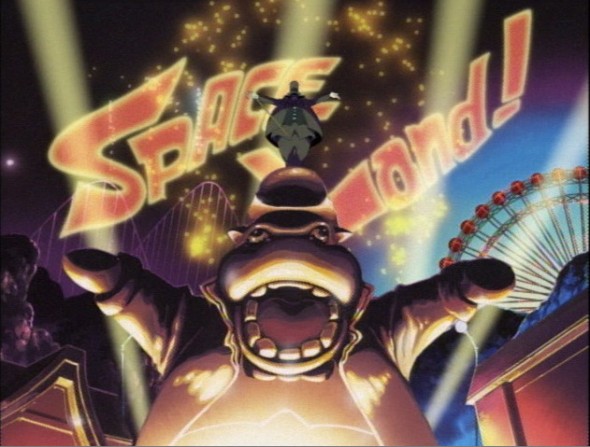
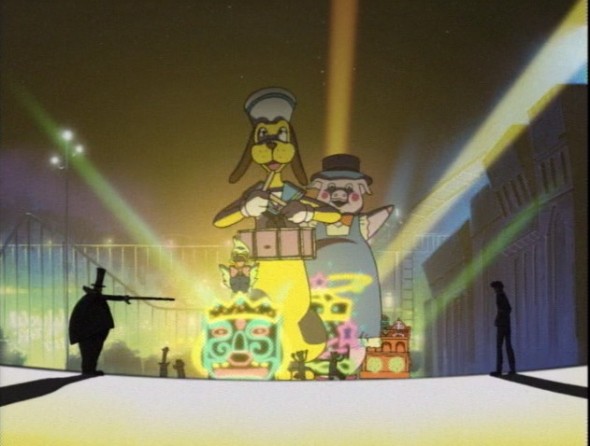
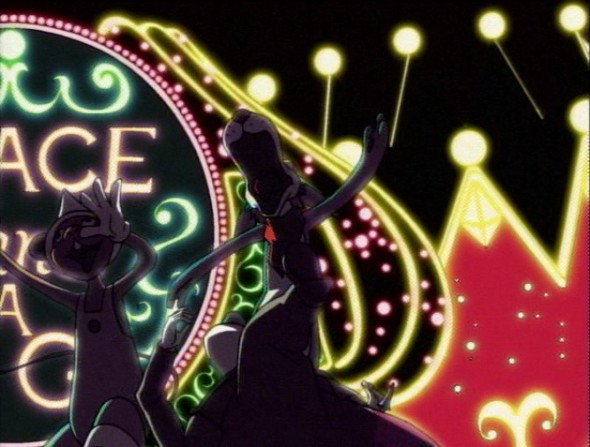
Interesting read as always Stokes. The Batman homage makes a lot of sense especially considering Japan’s love of Batman: The Animated Series. Assuming you haven’t already, you should check out Big O which is one huge homage to Batman: TAS…if Batman had a giant mech. Interestingly enough, Spike and Roger Smith (the main character and Batman stand-in of Big O) both share the same English voice actor (Steven Blum).
The name change is unfortunate for disrupting the musical thematic but I feel the reference to Pierrot le fou works much better as a title. It draws my interest (even though I haven’t seen the French film) and gives me a certain imagery of insanity especially considering the episode preview at the end of Session 19. The translated title, Requiem for a Mad Clown, gives me an entirely different mental image. It evokes a much more depressive imagery, which the episode does not really have. Pierrot does have a tragic backstory but the focal of the episode is the physics defying action and Spike’s ultimate vulnerability.
I also can’t wait for your take on Session 23: Cowboy Funk. It’s a personal favorite of mine.
This is one of my FAVORITE episodes – this and Wild Horses I tend to watch over and over and over again.
I’m very interested in your take on the end of Real Folk Blues. I did some insanely in depth analysis of that myself and I’m dying to find out if you saw what I saw.
Yeah, I noticed the Batman references in this one myself (of course, the Penguin came to mind, especially with the general build of Tongpu and some of his weapons, not to mention the penguins sliding towards Spike in the battle at Space Land.
Awesome. Just awesomely creepy!
Don’t worry man, Spike hated that animatronic dog too.
…now that’s some Overthinking! For a, what, 22 minute episode? Imagery knocked out of the park there Stokes!
Awesome! Love these pieces, Stokes.
Keeping with the musical reference theme, the episode should have been called something like “Laugh, Pagliacci” or “Vesti la Guibba.”
Although that probably would have pushed the character closer to the Joker than the Penguin — although, given the amusement part, the joker also seems conspicuous in his absence.
Tongpu is more of a combined reference to Penguin AND the Joker. He’s rotund and formally dressed certainly, but the characters do reference his constant smiling, and his laugh during the episode preview…speaks for itself.
PS: TOTALLY LOVING THESE!
Yes, this was great. I might be off my rocker, but I think there’s one Batman: The Animated Series episode that mirrors this to a very precise degree. Not the inversions, but if you imagined this told straight, then that. Which could potentially mean they, having worked on that episode, had a story they were well acquainted with, and could ask, “But how could that even fit into our world?” Again, might be off.
@Adrian, that’s kind of what I was thinking – Tongpu was a combination of Joker and Penguin. It fits so totally. Hell YEAH on the Batman reference. :)
Deleted — accidental post.
Forgive the last posting, it was pasted into the wrong window *dies of embarassment* If there is an administrator, please delete it.
Hello,
it’s been over 10 years since this was published and I have no idea if my message will ever be read by someone but I just wanted to let you know that I love all those insights on the show and particularly on session 20. It’s just so interesting to read all those thoughts of yours on just one singular episode ,especially since I just started cowboy bebop a few weeks ago.
Anyways, thanks again for this interesting post :D
I absolutely hated that animatronic dog as well. Anyways, that episode was different and dark and I loved watching it.